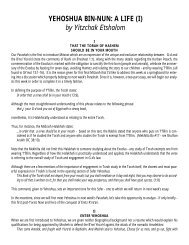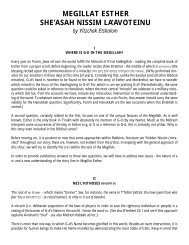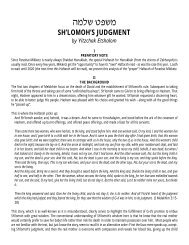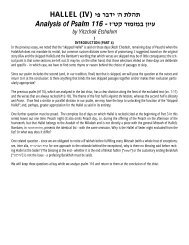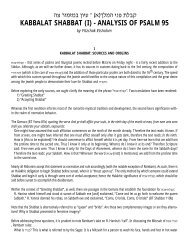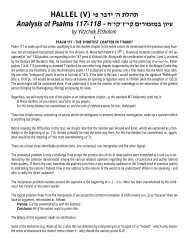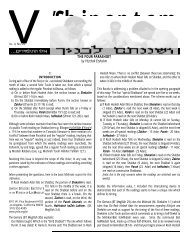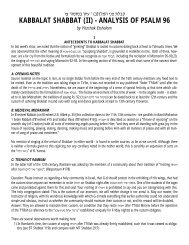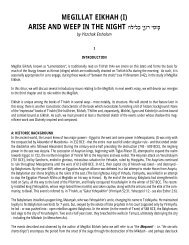KEVER RACHEL: THE âNORTHERN THEORYâ by ... - Torah.org
KEVER RACHEL: THE âNORTHERN THEORYâ by ... - Torah.org
KEVER RACHEL: THE âNORTHERN THEORYâ by ... - Torah.org
Create successful ePaper yourself
Turn your PDF publications into a flip-book with our unique Google optimized e-Paper software.
addition, understand the text to be D’var Hashem, we take the passion for truth one critical step further. We not only enjoy gaininggreater understanding and perhaps revealing the meaning of heretofore mysterious passages, we understand it to be a religiousobligation of the highest degree. What can serve the communication of Hashem’s word to the world more than the proper elucidationof the text?This must, of course, be undertaken with a great sense of humility and trepidation - but the knowledge that we are dwarfs standingatop the shoulders of the giants of the generations, guided <strong>by</strong> our Mesorah (so that we won’t jump to the shoulders of someother giant) and every aware of our responsibilities as interpreters of the text (so that shan’t f<strong>org</strong>et upon whose shoulders we stand)gives us security and comfort, as well as a constant prod to delve further, ask more probing questions and dig deeper to understandthe text.It is in the spirit of that Avodat Hashem that we undertake to present the less-popular theory regarding the location of -not to diminish, but to enhance, our appreciation and love for Torat Hashem and to explore every available avenue to understandingits depths.VEPHRATAH = BEIT LEHEMThe textual cornerstone of the “southern theory” is the location of mentioned in the narrative (B’resheet 35:19) and repeated<strong>by</strong> Ya’akov on his deathbed (ibid. 48:7) -And as for me, when I came from Padan, Rachel died <strong>by</strong> me in the land of Canaan in the way, when yet there was to cometo Ephrath; and I buried her there in the way of Ephrath; which is is Beth-Lehem.One of the critical points of interpretation is the meaning of . Although the Midrashim have used the phrase to identifythe season of Binyamin’s birth - based on various agricultural allusions in that abstruse phrase - most of the Rishonim understoodit to be a measure of distance (see, inter alia, the above-cited comment of Ramban [B’resheet 35:19] in its entirety). Given that, themost reasonable explanation of Kiv’rat Derekh is “a small way” (perhaps a mile or two) - as Ramban testifies. This would seem toseal the location of in the south - unless we can succeed in finding an alternate location for “Ephrat, which is Beit Lehem”.As a starting point, it should be noted that there is more than one town named in Eretz Yisra’el; Zevulun inherits, amongits cities, the town of (Yehoshua 19:15) - and Zevulun’s territory is far to the north. This is easily understood, since awas given that name due to its location amid wheat and barley fields. The town was the central locus for trade and processingof wheat and barley (as highlighted in Megillat Ruth). Hence, any area rich in grains would likely have, at its hub, a town named.There is one referent omitted in the two passages in B’resheet that is notable - when referring to the “famous” Beit-Lehem, the textoften clarifies its identification <strong>by</strong> appending “Yehudah” (see Shoftim 17 & 19:). Both references in B’resheet notethe proximity of Beit Lehem to Ephrat - but leave out the more familiar “Yehudah”. (This may be a moot point, since Yehudah wasnot yet given that land at this point - see, however, V’shinantam 5/3 where the mention of tribal inheritances in B’resheet is discussedat length.)Instead of beginning our search from , let’s start from the other landmark in the verse - .A few miles north of Yerushalayim, there is a spring that was, well into the 20 th century, a main source of drinking water for thecity. The spring is called “Ein-Farah” - which most Biblical geographers and cartographers identify with the city of mentionedamong the cities of Binyamin (Yehoshua 18:23). It is not unreasonable to posit that /Ein-Farah was alternatively called




